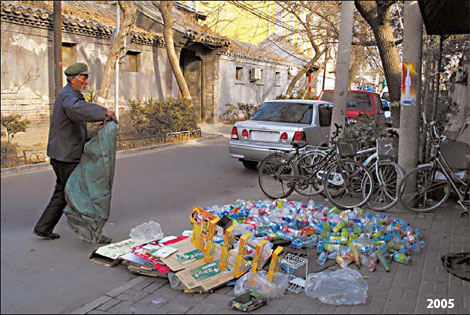|
|
 |
|
30th Anniversary Celebrations
New Rural Reform Efforts
Political System Reform
Changing Lifestyle
In Foreigners' Eyes
Commentary
Enterprise Stories
Newsmakers
Photo Gallery
Video and Audio
Wang Wenlan Gallery
Slideshow
Key Meetings
Key Reform Theories
Development Blueprint
Liu Shinan:
Don't go too far in name of sex education Hong Liang:
US should fix its own economic woes first Chen Weihua:
Need for medical privacy OP Rana:
This world dream can't be deferred Backward into the future
By YOU NUO (China Daily)
Updated: 2008-11-03 07:52

 Six hundred years ago Beijing was consisted of narrow streets called hutong. Those that exist today are under government protection in the inner city and must be at least more than 200 years old. Except for a few hutong under the government's special renovation program to attract tourists and shoppers, many of the old narrow streets have remained, the scenes of their daily lives evidence of the changes that the country has gone through. Buying groceries from mobile vendors who carried and hawked their goods on oversized tricycles cruising from one hutong to another used to be the morning activity of the hutong residents. Towards evening there would be another shopping session, with every vendor claiming his or her goods - from tender green onions to fruits - to be fresh from the suburban farms. In the early days of economic reform when the very phrase "market economy" was still a taboo, roadside markets were spontaneously formed by small and privately funded grocery vendors as you can see from our old photo this week. They were referred to awkwardly as a "commodity economy". What looked like a timid step, or half-step, in theory was a great leap forward in practice. As it turned out, the "commodity economy" in the 1980s was indeed China's starting point for the market economy. Nowadays, hutong has returned to their quiet pre-market normal life. Gone are the morning and evening markets and noise of vendors' hawking and boisterous bargaining between buyers and sellers. One can easily appreciate it by taking a stroll through a hutong in a weekday afternoon. Most people now get their groceries from the supermarkets and convenience stores where, of course, few items are truly fresh. Even the passing noise made by children going to and coming back from schools can in no way compare to the past, when people having fewer children and the urban population - not including the migrant workers - are aging. However, change continues. New ideas and new practices have come to stay and are reflected in the details of people's daily lives. The hutong neighborhoods are not only responsible for tidying and cleaning themselves, but are also engaged in many civil campaigns such as protecting the ancient architecture and trees. One of the changes, seemingly small but significant, has been recycling - the theme of our color photo this week. Organized collecting and recycling of household waste such as used paper, plastics and metals has been going on in hutongs, thanks in part to the close-knit neighborly relations. Some old hutongs are more advanced in the environmental movement than their suburban, middle class counterparts and perhaps also more careful than many industries.
 (China Daily 11/03/2008 page1)  
 |
主站蜘蛛池模板: 99久热在线精品视频观看 | 国产免费久久精品99 | 久草视频网站 | 精品国产免费观看久久久 | 99免费在线观看视频 | 精品久久久久久乐 | 涩涩国产精品福利在线观看 | 免费观看黄色毛片 | 久久毛片久久毛 | 欧美日韩视频一区二区在线观看 | 国产成人麻豆精品 | 国产成人久久精品激情91 | 欧美在线一区二区三区欧美 | 日本天堂免费 | 看真人视频a级毛片 | 毛片成人永久免费视频 | 中文字幕在线免费观看视频 | 国产伦理自拍 | 禁止18周岁进入免费网站观看 | 一区二区不卡视频在线观看 | 最新国产美女肝交视频播放 | 日韩区在线 | 欧美视频 亚洲视频 | 欧美成人观看 | 国产亚洲欧美日韩在线观看不卡 | 亚洲一区不卡 | 波多野结衣一区二区三区高清在线 | 姐姐真漂亮在线视频中文版 | 日韩欧美国产精品 | 国产精品99久久久久久人 | 国产成人精品999在线观看 | 免费观看欧美一级片 | 999久久久 | 日韩欧美亚洲视频 | 成人免费视频网 | 国产精品国产高清国产专区 | 国产一级片免费观看 | 亚洲欧美日韩中文字幕在线一区 | 情侣偷偷看的羞羞视频网站 | 久久国产精品女 | 日韩在线看片中文字幕不卡 |